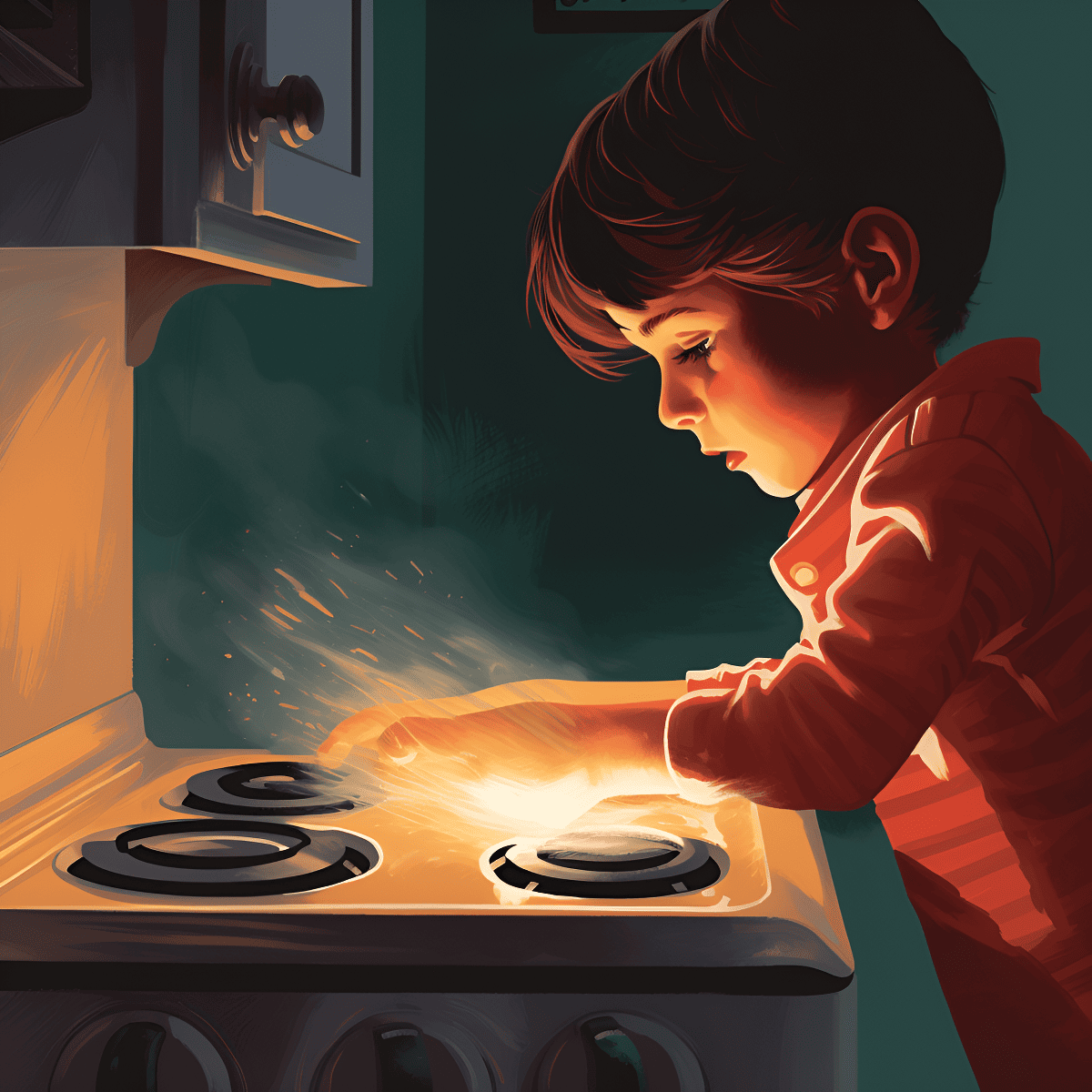Imagine you're walking through a garden and the sudden scent of blooming flowers hits you; it's an experience that requires no learning to appreciate. That’s the power of an unconditioned stimulus: it naturally, automatically triggers a response without any prior learning.
Unconditioned stimulus is a term used in classical conditioning to describe an event that leads to an instinctive reaction.
It's a part of the learning process that happens naturally, like flinching at a loud noise or feeling your mouth water when you see your favorite food. This built-in reaction doesn't need any training to occur, making it a cornerstone concept in understanding how we learn from our environment.
What is an Unconditioned Stimulus?

When you're out in the world, experiencing life, your senses are always at work. They pick up things around you, like the warmth of the sun on your skin or the sound of music playing in the distance.
Some of these sensations can make you react in a certain way without even thinking about it. This is where an unconditioned stimulus plays a big part in your everyday experiences.
Imagine you're sitting in a quiet room and suddenly, a fire alarm rings loudly. Your heart races, and you feel a rush to get to safety. That alarm is an unconditioned stimulus. It’s something that naturally and automatically makes you react.
Unconditioned stimulus is a fancy way of saying 'something that naturally causes a reaction'. This isn't something you've learned; it's built-in. Both physical and emotional reactions count.
For instance, if you touch a hot stove, your hand pulls back without thought. The hot stove is the unconditioned stimulus and your quick pull back is the unconditioned response.
It's important to understand these natural reactions in psychology because they explain a lot about how learning happens.
Where did the Term Come From?
Long before our current understanding of psychology, the concept of an unconditioned stimulus was born. It was in the early 20th century that a Russian scientist named Ivan Pavlov made a discovery that would change the way we think about learning and behavior.
While researching digestion in dogs, Pavlov noticed something curious. The dogs began to salivate not only when they tasted food but also when they saw the lab assistant who usually fed them.
This reaction was automatic, a natural response to what the dogs had come to expect. This was the birth of what Pavlov would call the unconditioned response to an unconditioned stimulus.
Pavlov’s work laid the groundwork for what is now known as classical conditioning. It's also known as Pavlovian Conditioning. This is a way of learning where a natural, automatic response to one stimulus becomes linked to a new, unrelated stimulus after they occur together many times.
The beauty of Pavlov's discovery lies in its simplicity and the powerful insight it provides into the mechanics of learning. Pavlov's findings were so fundamental that they earned him the Nobel Prize in Physiology or Medicine in 1904, cementing his work's importance in psychological science.
His research has been modified since then, especially taking into consideration ethics, which are now mandatory guidelines in psychological research.
Unconditioned Stimulus in Classical Conditioning

Think of classical conditioning as a learning process, a way your brain connects things that happen around you with your reactions.
The unconditioned stimulus is a star player in this process. It naturally brings out a response without any need for learning. In the world of classical conditioning, this is like your reflex when a doctor taps your knee. You didn't learn to jerk your leg; it just happens.
Now, when you're studying how learning works, classical conditioning is a key topic. The unconditioned stimulus works together with a neutral stimulus – something that doesn’t cause a response at first.
But after they show up together many times, your brain starts to link them. Soon, that neutral stimulus can cause the same response on its own. That’s the power of classical conditioning.
Understanding the role of the unconditioned stimulus helps you see why you might start to feel hungry just by seeing your lunchbox, even if you're not smelling or tasting food yet.
Your body has learned to connect the sight of the lunchbox (which was a neutral stimulus) with the feeling of hunger and eating (the unconditioned response to food, the unconditioned stimulus).
So, as you learn about psychology, remember how these automatic, natural responses play a part in the bigger picture of learning. They're the foundation for making new connections in our minds.
29 Examples of Unconditioned Stimulus
1) Smelling Food
When you catch the aroma of food cooking, you might notice your stomach growls. That's because the smell acts as an unconditioned stimulus, automatically signaling your body to prepare for eating.
2) Sudden Loud Noises

Jumping at a loud sound, like a firecracker bursting, is a reflex. The sudden loud noise itself is the unconditioned stimulus, creating an instant reaction without any prior learning.
3) Bright Lights
Squinting in bright light is something you do without thinking. The bright light acts as an unconditioned stimulus, triggering a blink or squint to protect your eyes.
4) Extreme Temperatures
When you touch something very cold, like ice, you reflexively pull away. The ice is the unconditioned stimulus, prompting an immediate withdrawal response.
5) A Sudden Touch
If someone taps you unexpectedly on the shoulder, you might twitch or turn around. The unexpected touch serves as an unconditioned stimulus, leading to a more reflexive response or movement.
6) Tasting Sourness

The instant pucker when you taste something sour, like a lemon, is automatic. The sour taste is the unconditioned stimulus that produces the puckering response.
7) Feeling Pain
Pain, such as a pinch, is an unconditioned stimulus that elicits an automatic response like saying "ouch" or pulling away from the source.
8) The Smell of Smoke
The detection of smoke will often lead to coughing or a need to move away from the scent. Smoke serves as an unconditioned stimulus triggering a protective response.
9) An Itch
When you feel an itch, scratching it is the direct unconditioned response to the itchy sensation, the unconditioned stimulus.
10) Tasting Sweetness
Experiencing a natural desire to eat more when tasting something sweet is an unconditioned response to the unconditioned stimulus of the sweet flavor.
11) Hearing Your Name
Turning your head when you hear your name is an automatic response. Your name acts as an unconditioned stimulus that demands attention.
12) Sexual Arousal
Physical signs of sexual arousal in response to an erotic image or thought occur naturally, with the image or thought being the unconditioned stimulus.
13) Feeling Dizzy
When you spin around and suddenly stop, the disorientation and dizziness you feel are unconditioned responses to the spinning, the unconditioned stimulus.
14) Physical Exhaustion
After intense physical activity, panting or feeling tired is an automatic response to the unconditioned stimulus of the exercise.
15) Nausea at Sea

Feeling seasick due to the rocking motion of a boat is an unconditioned response to the unconditioned stimulus of the movement.
16) Blushing When Embarrassed
When you're embarrassed, blushing is an automatic reaction. The feeling of embarrassment is an unconditioned stimulus causing your cheeks to turn red.
17) Watery Eyes from Cutting Onions
The sting in your eyes and subsequent tears when you cut onions are unconditioned responses to the chemicals released, which are the unconditioned stimuli.
18) Yawning When Tired
Yawning as a reaction to fatigue is a natural response. The tiredness acts as an unconditioned stimulus, leading to the unconditioned response of yawning.
19) Flinching from a Bee Sting
The sharp pain and subsequent flinch from a bee sting occur without learning. The sting is the unconditioned stimulus that automatically produces the flinching response.
20) Salivating at the Thought of Food
Just thinking about your favorite food can make your mouth water. The thought or image of the food is an unconditioned stimulus that elicits salivation.
21) Shivering in Cold Weather
Shivering when it's cold is your body's natural way to generate heat. The cold temperature is the unconditioned stimulus that naturally triggers the shivering response.
22) Sweating in Heat
Your body starts to sweat when it's hot to cool down. The high temperature is the unconditioned stimulus, causing the sweat glands to activate.
23) Startling at a Flash of Lightning
When lightning suddenly illuminates the sky, the instinct to startle is an unconditioned response to the bright flash, the unconditioned stimulus.
24) The Knee-Jerk Reaction
The knee-jerk reaction during a reflex test is an unconditioned response to the tap on the knee, which is the unconditioned stimulus.
25) Crying from a Strong Odor
Tearing up from a strong odor, like ammonia, is an automatic response. The odor acts as an unconditioned stimulus causing the eyes to water.
26) Laughing at a Ticklish Touch
The involuntary laughter when you are tickled is an unconditioned response to the tickling sensation, which is an unconditioned stimulus.
27) Sneezing from Dust
A sneeze is a natural reflex to clear your nasal passage when it's irritated by dust, which is the unconditioned stimulus.
28) Feeling Sleepy at Bedtime
The drowsiness you feel at your usual bedtime is an unconditioned response to the habitual stimulus of the time of night, your personal unconditioned stimulus.
29) Gasping for Air After a Dive
The deep breath you take when resurfacing after a dive is an unconditioned response to your body's need for oxygen, making the lack of air the unconditioned stimulus.
Unconditioned vs. Conditioned Stimulus
When you're learning about the fascinating world of psychology, it's crucial to know the difference between two key terms: unconditioned stimulus and conditioned stimulus. They might sound similar, but they play very different roles in how you learn and react to the world around you.
An unconditioned stimulus is a bit like your favorite cozy blanket. It naturally and automatically makes you feel warm without any effort.
In the same way, an otherwise unconditioned stimulus naturally triggers and causes a reaction. This is something you're born with the ability to respond to, like pulling your hand back from a hot stove. You don't need to be taught that; your body just knows.
On the other hand, a conditioned stimulus doesn't mean much to you at first, but after you learn that it should have a particular response, it comes naturally.
The conditioned stimulus starts as a neutral stimulus – something that doesn't cause a response – until it's paired with an unconditioned stimulus enough times to elicit a reaction on its own. This reaction is called the conditioned response.
So, remember: the unconditioned stimulus is automatic and natural, like sneezing when pepper tickles your nose. The conditioned stimulus, though, is learned.
It's like feeling hungry when you see the golden arches of a fast-food restaurant after many times of eating there. You've learned to associate that symbol with the taste and satisfaction of food.
The Impact of Unconditioned Stimuli on Behavior

The things that happen around and to you can shape the way you act, often without you even noticing. Unconditioned stimuli are powerful because they tap into the basic wiring of your brain, influencing your behavior in a big way.
Think of unconditioned stimuli as the natural forces in life. They don't ask for permission; they just happen, and they bring about a natural response.
For example, when you eat something with sugar, your body will likely react with pleasure. That’s because the taste of sugar is an unconditioned stimulus that leads to a satisfying feeling, encouraging you to eat more.
These stimuli play a significant role in your everyday behavior. They can set off emotions, actions, and even habits. If you've ever found yourself reaching for a warm cup of tea on a cold day without thinking, that’s the unconditioned stimulus of cold weather guiding your behavior towards seeking warmth and comfort.
Unconditioned Stimulus in Human vs. Animal Learning
When it comes to learning, humans and animals are not so different. An unconditioned stimulus is a concept that applies across the board, whether you have two legs or four, feathers or fur.
For animals, unconditioned stimuli are a big part of how they learn to survive. A loud noise might make a bird fly away, or a bright light could cause a fish to swim deeper. These reactions happen without teaching; they are built-in responses to the world that help animals stay safe.
Humans respond to unconditioned stimuli too, but we also have complex brains that let us think and reflect on these responses.
A baby might automatically pull away from a bitter taste, just like an animal would. As we grow up, we can learn to like that bitter taste if it's paired with something we enjoy, like the rich flavor of coffee with a favorite morning routine.
The real takeaway here is that unconditioned stimuli are a starting point for learning in all creatures. They set the stage for more complex learning that can be quite different for humans and animals.
We humans use our experiences to build a vast web of understanding, adding layers of meaning and emotions to the raw reactions that started with a simple unconditioned stimulus.
How to Identify an Unconditioned Stimulus in Experiments
An unconditioned stimulus in psychological experiments is the piece of the puzzle that naturally causes a response, the original trigger that doesn't need any training to be effective.
In experiments, psychologists often look for a reaction that occurs without prior learning. If you're watching a study unfold, pay attention to what automatically causes a subject to respond.
For instance, in Pavlov's famous experiment, the unconditioned stimulus was the food that made the dogs salivate, not the bell that was rung before feeding them.
When you're trying to find the unconditioned stimulus in an experiment, look for the element that's not being manipulated or changed by the scientist. It’s the consistent factor that elicits a response every time it appears.
In studies with humans, it might be a puff of air that causes a blink or a loud sound that makes someone jump.
Remember, identifying an unconditioned stimulus is all about looking for the natural, automatic reaction in the test subject. Once you spot that, you've found the key to understanding the behavior the experiment is trying to explore or explain.
Tips for Remembering Unconditioned Stimulus for Tests
Remembering the concept of an unconditioned stimulus for a test doesn't have to be daunting. With a few strategies, you can lock this term in your memory.
First, try to create a vivid mental image. Picture a steaming hot pizza. You don't need to learn to feel hungry when you see it; it just happens. That hunger is your natural, unconditioned response to the unconditioned stimulus of the pizza. Visualizing real-life examples can make the concept stick.
Another tip is to use mnemonics, which are like secret codes to help you remember. For unconditioned stimulus, you might think of "U.S." as "Usually Simple," since the unconditioned stimulus is usually a simple, natural trigger that doesn't require any learning.
Lastly, make up a catchy rhyme or phrase. For instance, "The sight of a bee makes you flee; that's an unconditioned stimulus, easy to see!" Playful and rhythmic sentences can make recall easier when you're sitting down for your exam.
Incorporate these tips into your study routine, and when test day comes, you'll be ready to identify and explain unconditioned stimuli with confidence. It's all about making the concept familiar and relatable, so it feels like second nature to you.
Frequently Asked Questions (FAQ)
1) What exactly is an unconditioned stimulus?
An unconditioned stimulus is something in the environment that naturally and automatically triggers a response without any learning needed. It's a fundamental aspect of the learning process in both humans and animals.
2) Can you give me a real-life example of an unconditioned stimulus?
Sure! A common example is when you touch something hot and immediately pull your hand back. The heat is the unconditioned stimulus because it naturally causes the withdrawal response.
3) How does an unconditioned stimulus differ from a conditioned stimulus?
An unconditioned stimulus triggers a response naturally, while a conditioned stimulus only causes a response after it has been associated with an unconditioned stimulus through learning. For example, a dog's salivation in response to seeing food is natural (unconditioned), but salivating to the sound of a bell after the bell has been paired with food is a learned response (conditioned).
4) Why is understanding unconditioned stimuli important in psychology?
Understanding unconditioned stimuli is important because it helps psychologists comprehend how basic learning processes work. This knowledge can then be used to understand more complex behaviors and even to develop treatments for various psychological conditions.
5) Can an unconditioned stimulus change over time?
Typically, an unconditioned stimulus remains consistent in eliciting a natural response. However, one's sensitivity to it can change due to various factors such as repeated exposure or changes in physiological states.
6) How do unconditioned stimuli play a role in classical conditioning?
In classical conditioning, an unconditioned stimulus is used to create a new association with a previously neutral stimulus, which then becomes a conditioned stimulus. This conditioning process also forms the basis of how associative learning occurs.
7) Is the response to an unconditioned stimulus the same for everyone?
While the basic response to an unconditioned stimulus tends to be universal, individual differences such as past experiences and biological factors can influence the strength and specific nature of the response.
8) How can identifying an unconditioned stimulus be useful in behavior therapy?
Identifying an unconditioned stimulus can help therapists understand the underlying natural reactions in a person and can be used to build or alter associations during therapy, aiding in the treatment of disorders like phobias or anxiety.
9) What role do unconditioned stimuli play in our everyday lives?
Unconditioned stimuli are constantly influencing our behavior by triggering natural responses such as hunger, thirst, or startle, which then guide our daily decisions and actions without us needing to think about them.
10) Can unconditioned stimuli be used in education?
Yes, educators can use the concept of unconditioned stimuli to help students make natural connections between new information and inherent responses, potentially enhancing the learning experience and retention of knowledge.
Conclusion
In wrapping up our exploration of the unconditioned stimulus, it’s clear that this concept is more than just a term in a psychology textbook. It’s a thread woven into the fabric of our daily lives, shaping our reactions and behaviors in ways we often overlook.
From the automatic jerk of your hand from a hot surface to the immediate pleasure of a sweet taste, unconditioned stimuli are the natural responses embedded in our biology.
Understanding the unconditioned stimulus gives you insight into the fundamental processes of learning and behavior. It can help you make sense of why you react the way you do in certain situations, and even how these instinctive reactions can be shaped and changed over time through learning and experience.
